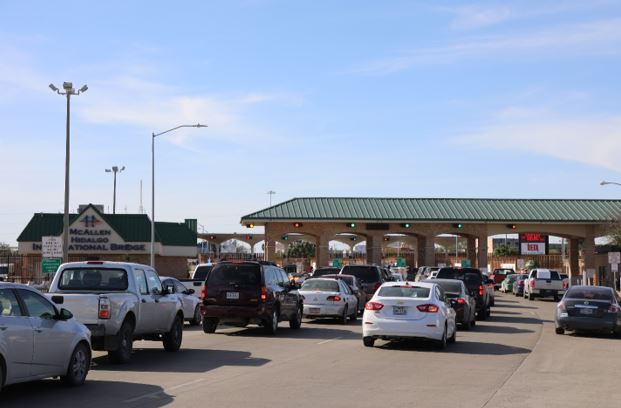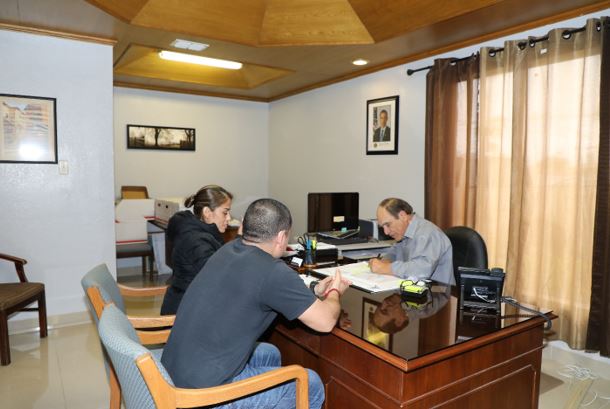
Hidalgo Port of Entry. (Photo: Zhang Mengxu)
Washington (People's Daily) -- Hidalgo Port of Entry is the main corridor connecting McAllen, Texas, and Reynosa, Mexico, with annual border crossings of over 10 million people. Recently, I visited this border area.
In front of me, cars and pedestrians intensively cross into the other country. The huge flow of people has spawned a prosperous border trade. The River market, a large second-hand goods market just 50 meters from the port of entry, offers commodities from clothing to furniture and appliances. On a weekend morning, hordes of people come here to shop.
There are also dozens of duty-free stores on the main street. Haviat works in one of them, he told People’s Daily that many Mexicans take duty-free goods home every day - prices are 25 percent lower than the market price.

People choosing second-hand goods in River Market. (Photo: Zhang Mengxu)
However, less than 100 meters behind these bustling commercial shops is the border wall. The US-Mexico border is 1954 miles long and the existing border wall is 654 miles. The goal of US President Trump is to build a wall along the entire border. When I stood on the US side, a US border patrol car whistled past me, which usually indicates that people were spotted trying to cross illegally.

The border wall near Hidalgo Port of Entry. (Photo: Zhang Mengxu)
Not long ago, on January 10, Trump visited McAllen. He described the security and humanitarian situation on the US-Mexico border as a “crisis”.
"Crisis? Where is the crisis?" Benigno Pena, a 70-year-old local resident, told People’s Daily. Pena was born here, but his parents used to be undocumented immigrants from Mexico. Pena operates a legal service agency called "South Texas Immigration Council" in McAllen committed to assisting undocumented immigrants apply for asylum, appealing repatriation orders, and helping immigrants apply for green cards. He has been doing this for 40 years.
“Trump depicts this place as a center for crime, drug trafficking and gang violence. In fact, McAllen’s law and order is much better than Chicago. The last murder was more than a year ago,” said Pena. "Why should we use a wall to separate each other?"

Benigno Pena meeting with clients. (Photo: Zhang Mengxu)
McAllen is a small town with a population of about 140,000. Hispanics account for 75 percent of the population. From San Diego, Calif., to Brownsville, Texas, there are dozens of such border cities along the border.
In a restaurant in downtown McAllen, I met with Noville, who is 50 years old, his parents also came from Mexico. When I asked his view on the border wall, he replied bluntly, "This is a waste of money. The business of the whole city is highly dependent on people from Mexico. The service industry and agriculture also need Mexican labor. Why use a wall to break us?"
The border wall has become a highly divided topic in the United States. According to CNN, about 57 percent of people oppose the wall, while 38 percent support it. But at the US-Mexico border, opposition to the wall completely overwhelms support for it. Pena said many residents living on the Mexican side also hold legal resident status in the United States. They choose to live in Mexico and queue up at 5 or 6 in the morning to go to work on farms, at supermarkets, or restaurants on the US side. In the evening, they go back to Mexico.
People cross the border to return to their homes in Mexico. (Photo: Zhang Mengxu)
Menchaka Martha is a professor of anthropology at the University of Texas, Austin. She told People’s Daily, the flow of people from Latin American countries to the United States is a phenomenon that has existed for centuries.
“These people hope to pursue more opportunities and a better life in the United States,” she said. “As a country of immigration, the United States has generally benefited from immigration, whether it is legal or illegal. The current Trump administration wants to strengthen the management of immigration issues and selectively accept high-level immigration. But the crux of the matter is that Congress should fully discuss these issues, and the current border wall deadlock has clearly diluted the focus of the discussion.”
How to deal with immigration issues is always a difficult knot in American politics. In the past two years, the immigration reform bill proposed by the Republican Party has been stranded several times in the House of Representatives.
Martha said that the US government's contradictions and policy chaos on immigration issues have profoundly reflected the division and polarization of American politics, society and public opinion. Since the immigration reform bill was introduced in the United States in 1996, the current immigration policy system has not undergone major reforms for more than 20 years.
The reason for this situation is that any reform plan will have a support and opposition rate of nearly 5:5. The two parties are worried that touching this issue will reduce their support base, so they hand off the puzzle to the next session. Therefore, every US president and Congress have preferred to introduce bills on specific areas of immigration, rather than re-examine and revise the overall situation.
Pena told People’s Daily that there is only one way to solve the immigration paradox facing the United States, which is to face up to the shortage in the US labor force and open up more job visa opportunities. However, because this would mean increasing the cost of labor, employers would hire illegal immigrants without insurance and pay wages far below market value. Opening work visas would also incur strong opposition from anti-immigration forces.
How to solve the immigration problem facing the United States? There is currently no feasible solution.


